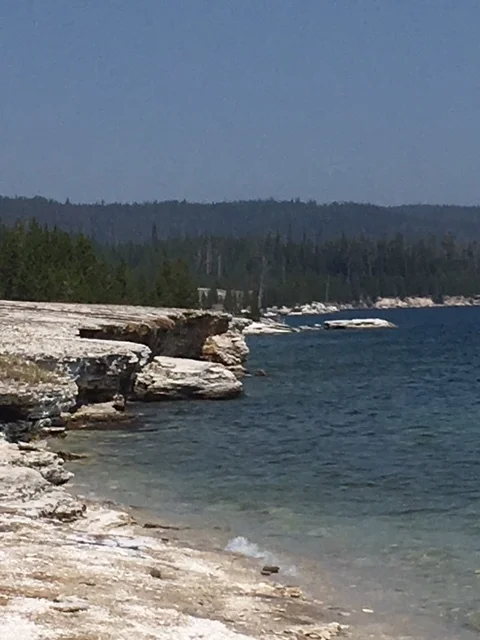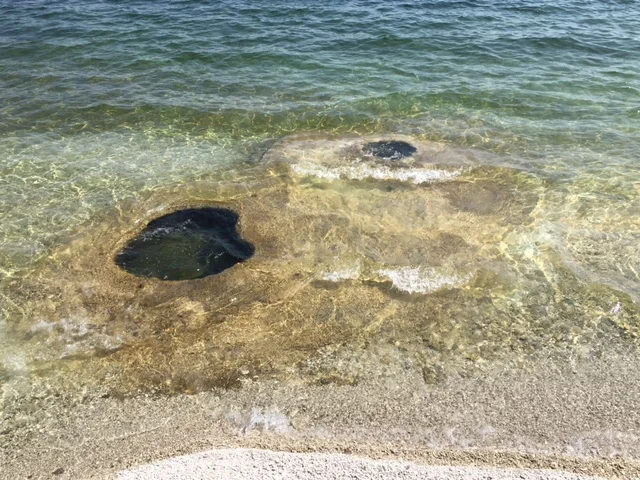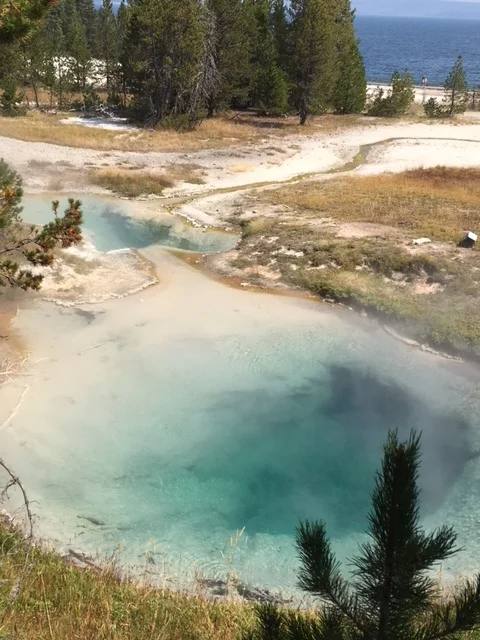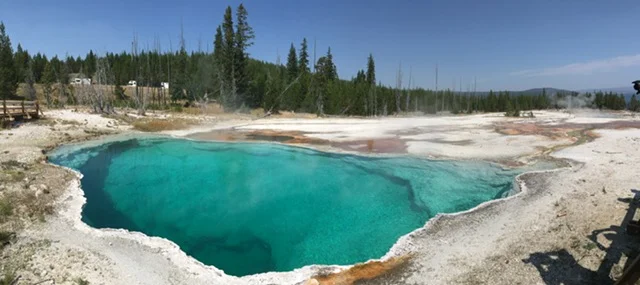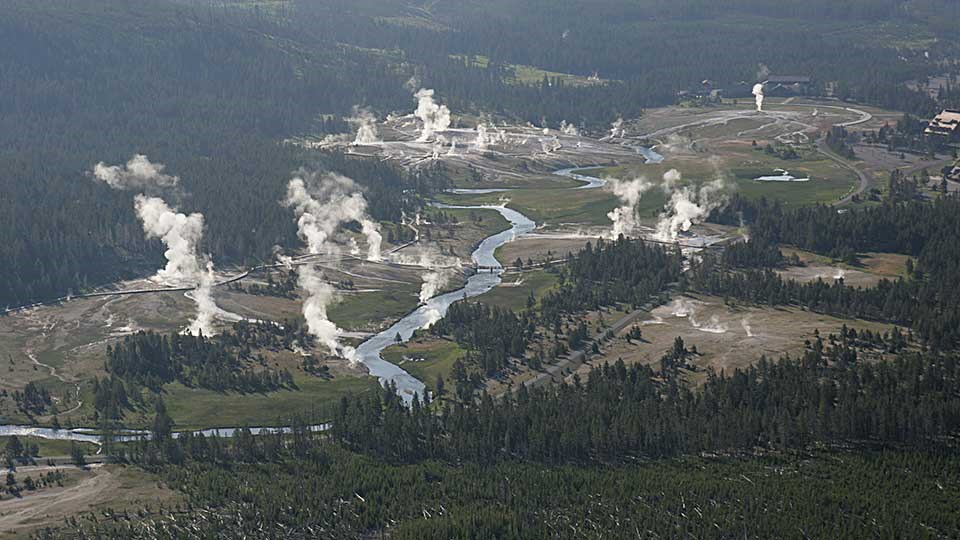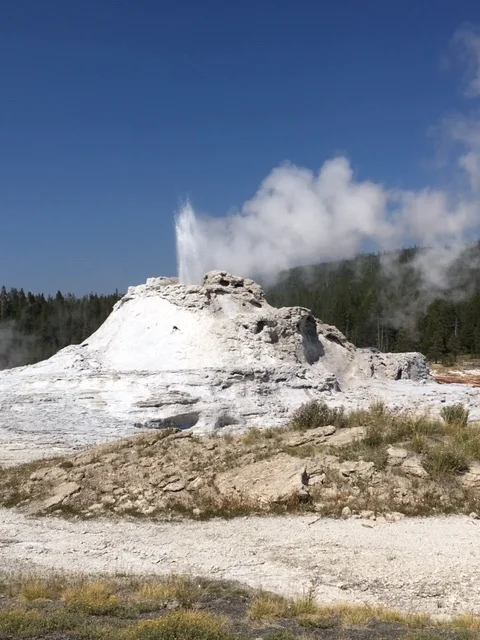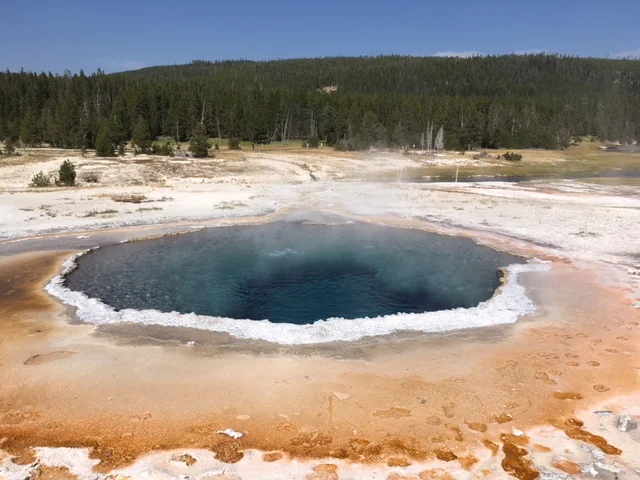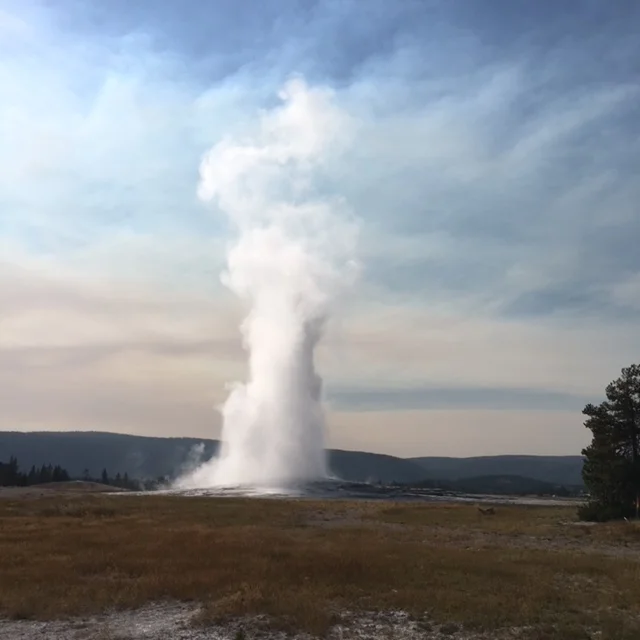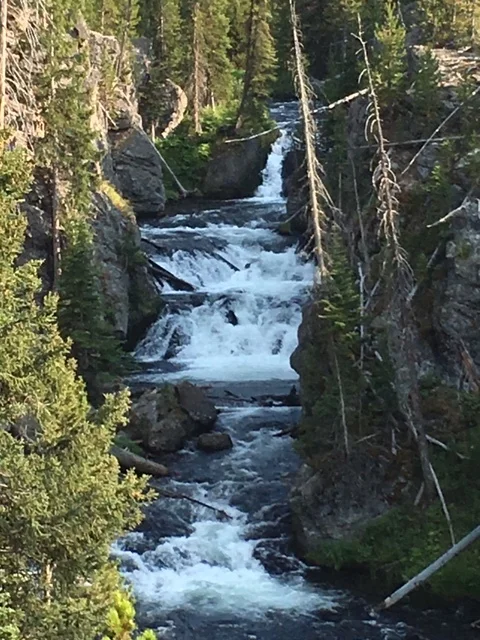Yellowstone National Park – Day 3
Wyoming
Wednesday, August 15, 2018
Smoky, 89°
“It spouted at regular intervals nine times during our stay, the columns of boiling water being thrown from ninety to one hundred and twenty-five feet at each discharge, which lasted from fifteen to twenty minutes. We gave it the name of "Old Faithful."
- Nathaniel P. Langford wrote in his 1871 Scribner's account of the expedition
Moving day from Bridge Bay to Grant Village campgrounds was an easy move - about thirty miles down the road. It is located on the south end of Yellowstone Lake close to the West Thumb Geyser Basin. It is amazing that this National Park is at a high elevation between 7,000 to over 8,000 feet above sea level, the largest lake at high elevation in North America. You do not think about that fact until you are doing activities. This is a place where there are many hiking trails that lead to the attractions within the park. The altitude affects your stamina as breathing harder zaps your endurance and makes your body feel worn out at day’s end.
Grant Village campground is large, with 430 campsites, running water restrooms, and like all of the National Parks, pay to use showers. At this camp ground, the fee includes two showers a day which is a nice added bonus. It is in a beautiful setting with some sites on the lake, all with picnic tables and fire pits. It sits among lodge pole pine trees and there is space between campsites for some privacy giving things a nice feel. We spent the first two days exploring the northern areas in the park, both on the east and west side. Today, we will be exploring the southern areas of the park including the West Thumb Geyser Basin close to the campground and the areas around the Old Faithful Inn and the famous geyser.
The West Thumb Geyser Basin is one of the smallest geyser basins in Yellowstone and is located on the shore of the lake. It easily ranks as the most scenic that we have seen so far. West Thumb is a caldera within a larger caldera. Active hydrothermal features exist on the lake bottom and elsewhere in the lake. It has an easily navigated boardwalk and trail system providing terrific views of the various hot springs and thermal features.
West Thumb Geyser Basin
There was a large circular loop with an inner boardwalk connecting the outer loop sections. The outer loop went along the lake’s edge where there were several interesting features. It did not matter which direction you walked as each trail section connected to another and passed all of the dynamic water features.
West Thumb derived its name from the thumb-like projection of Yellowstone Lake and the name was given by the 1870 Washburn Expedition. It was also known as Hot Spring Camp. West Thumb has less geyser activity than other basins. But West Thumb, for its size, has it all-hot springs, pools, mud pots, fumaroles and lake shore geysers.
Fishing Cone has been the most popular feature. Its unusual location along the lake shore and its symmetrical cone were popularized by early stories of "boiled trout." Abyss Pool is also noted for its depth and colors.
The Thumb Paint Pots are constantly changing. In the 1920s and 30s they were very extensive and active. Now they are less active but, depending on moisture, they still build mud cones.
Since the mid-1970s, West Thumb has decreased in thermal activity. Some temperatures have cooled in the basin allowing large colonies of algae and cyanobacteria to grow. As a result, large newly-formed microbial mats flourish on the run-off channels and along the edges of pools. (yellowstonenationalpark.com)
The three main features actually in the lake were: Lakeshore Geyser, Fishing Cone, and Big Cone.
Lakeshore Geyser - Temperature 198.6°F, Interval 30-60 minutes-dormancy. Duration 10 minutes. Height 20-30 feet. Lake Shore Geyser is very similar to Fishing Cone. It is also on the Shore of Yellowstone Lake, but its vent is usually covered by water. By August or September the water level is usually low enough to expose the crater. Lake Shore Geyser has long periods of dormancy and geyser predictions are difficult. When it does erupt, a column of water reaches 20-30 feet high which gradually decreases in force after ten minutes.
Lakeshore Geyser
Fishing Cone - Temperature 170.4°F, Interval dormant. Duration minutes to hours. Height 3 feet. Fishing Cone is a thermal feature unique to Yellowstone. It is situated on the shore of Yellowstone Lake and received its name from early explorers who stood on the cone and cast their lines into the lake to catch fish. Without taking the fish off the hook they parboiled them in the vent of Fishing Cone. However, the shoreline has changed since those times; Fishing Cone is usually inundated by high water during the early summer. It erupted once during the 1920s and '30s but the cold water of the lake has altered its eruptive behavior.
Fishing Cone
Blue Funnel Spring - Temperature 172-182°F, Dimensions 18 feet diameter. Blue Funnel Spring is a small, blue concentric pool located in the center of West Thumb Geyser Basin. When one walks past this spring, its vent appears to move and re position. This phenomenon is not unique to Yellowstone's thermal features, but it is easily observed in Blue Funnel Spring. It is an optical illusion caused by refraction. It results when light traveling through the air strikes the surface of water at an oblique angle. One side of the wave front enters the water before the other and is retarded-since light travels more slowly in water than in air-while the other side continues to move at its original speed until it too reaches the water surface. As a result, the light ray bends in the denser water and is refracted, giving the illusion that an object has a different location than it actually has.
Blue Funnel Spring
To the west side of the boardwalk was Abyss Pool. It was deep with a beautiful blue/Aquamarine color.
Abyss Pool - Temperature 172°F Dimensions 30x57 feet. Depth 53 feet. Abyss Pool is a colorful and interesting pool in the West Thumb Geyser Basin. Abyss is the deepest pool known in Yellowstone and received its name for its abyss-like depth. The dark green-colored water gives the illusion of a bottomless pool. Vandalism may have changed this pool's temperature. Coins and other debris thrown in have caused the vent to plug. The reduced spring flow also reduced the pool temperature, allowing abundant algae growth along the edge and run-off channels. The extensive microbial mats now support ephydrid flies, spiders and killdeers. An unusual eruption in 1987 caused the pool to surge and temporarily destroyed the microbial mats.
(Narratives above: www.yellowstonenationalpark.com/westthumb.htm)
Abyss Pool
Leaving West Thumb, it was finally time to head to Yellowstone’s premier attraction, “Old Faithful” which was about thirty minutes away. Traffic was moderate throughout the Park this time of year but it was heavy at the entrances and parking areas to the most popular attractions. Old Faithful was not exempt from the traffic or the people walking about. Most of the parking lots were at full capacity but pulling around and following a couple of signs we were able to find a parking space for the RV that literally was as close as you could park to Old Faithful. It was next to the information center which also had gift shops and a snack bar and was located about 500 feet from the viewing benches on the boardwalk in front of the geyser.
The Upper Geyser Basin, approximately two square miles in area, contains the largest concentration and nearly one-quarter of all of the geysers in the world.
Aerial View of the Upper Geyser Basin (Photo by NPS) (Old Faithful upper right)
A variety of thermal features exist here: spouting geysers, colorful hot springs, and steaming fumaroles. Those names include Old Faithful-named for its regular eruptions; Beehive Geyser-with its bee-hive shaped cone; and Riverside Geyser-named for its location on the Firehole River. The Upper Geyser Basin is the home of Old Faithful, the most famous and celebrated geyser in the world. The 1870 Washburn Expedition camped near Old Faithful and discovered the geyser had frequent and regular eruptions over 100 feet. They dubbed the geyser Old Faithful. It erupts once approximately every 45 to 90 minutes, depending on the duration of the previous eruption. (www.yellowstonenationalpark.com)
It was about twenty five minutes before the next “scheduled” eruption of Old Faithful so we had plenty of time to go to the bathroom and visit the gift shops. The benches in front were starting to fill so it was time to take a seat and wait for the big moment. You could see steam trails coming out of the vent in the ground on the mound in front of all the spectators. People talked, some excitedly about what they expected to happen and when it was going to occur. It was funny to watch people making room for others explaining why someone could not sit here or there. The park ranger nearby was telling everyone how the time for the next eruption is estimated. A ranger in an office at the Old Faithful Inn looks out the window and times the latest eruption and determines approximately how high it shoots into the air so they can estimate the next eruption, within a 20 minute window, based on the records over the years. To predict the next eruption, its first continuous surge is timed until the final splash. If the total eruption is less than four minutes, the next eruption will occur in approximately 40-60 minutes. If the eruption is four minutes or longer, the next interval will be 75-100 minutes. Everyone laughed at how “scientific” predicting the next occurrence was.
It did not take long for “Old Faithful” to repeatedly expel a steam plume from its vent in the ground and with every third or fourth steam burst, belch a small column of water several feet into the air. The crowd’s anticipation grew and the sounds of their “ooohhs and ahhhs” could be heard above the geyser’s noises. Soon, a burst of water and steam went about fifteen feet into the air and “Old Faithful” started her show for everyone.
Old Faithful First viewing
With a loud whooshing sound the water and steam plume shot into the air. The steam blew away from the main column of water rising high into the air and fell away to the ground creating a small rainbow in its mist. The crowd went into a frenzy taking photos, videos, and selfies as the geyser shot water and steam out of the ground.
This lasted for several minutes as the height reached approximately one hundred feet above the ground. Once the main event started to subside the height dropped to about fifty feet, then twenty five, and stopped shortly thereafter cycling itself for another blast in about ninety minutes.
The crowd scattered once it was over, some heading into the information center or café while others headed over to the Old Faithful Inn to see this historic building and its construction. The rest of us, headed down the long boardwalks that make up the Upper Geyser Basin to view more thermal features, the first one was Castle Geyser.
Castle Geyser - Temperature 200°F Interval 9-11 hours. Duration 1 hour. Height 60-90 feet. Members of the 1870 Langford-Doane Expedition named this feature for the "resemblance to the ruins of an old castle." The large sinter cone is nearly 12 feet high with a diameter of 20 feet at the top. Castle was an irregular geyser, with periods of dormancy, before the 1959 earthquake. Since the earthquake, it has been a regular, easily predictable geyser. The water phase of an eruption lasts about 15 minutes and a steam phase, similar to a steam locomotive, lasting an additional 45 minutes. Subterranean connections exist between Castle and Crested Pool. (www.yellowstonenationalpark.com)
Castle Geyser Blowing Steam
Morning Glory Pool - Temperature 171.6°F Dimensions 23x26.6 feet. Depth 23 feet. A deep, funnel-shaped pool with a dark blue center. The resemblance to the corolla and color of a morning glory is responsible for its name in the early 1880s. It has been a popular thermal feature and a symbol of Yellowstone. The early stagecoach and automobile road came within a few feet of this pool until 1971 when the road was rerouted. Early visitors carelessly removed the delicate scalloped border and dumped debris into the pool. In 1950 the water level was lowered by siphoning which induced the pool to erupt. Socks, bath towels, 76 handkerchiefs, $86.27 in pennies, $8.10 in other coins came up; in all, 112 different objects were removed from Morning Glory. The debris had reduced the flow of water and contributed to the decline in temperature, causing bacteria to grow in the cooler yellow and orange edges of the pool. (www.yellowstonenationalpark.com)
Morning Glory Pool
The long walk around the Upper Geyser Basin took about an hour and a half - just about the time for Old Faithful to erupt again.
Upper Geyser Basin Walk
The walkway crossed the rolling hills with many geothermal features that were spewing steam, bubbling mud, or sending small bursts of boiling water and steam up into the air.
With names like, Sawmill Geyser, Spasmodic Geyser, and Liberty Pool the path takes you to a circular boardwalk to features like; Lion Group, Heart Spring, Plume Geyser, Anemone Geyser and to the main feature called Beehive Geyser.
Beehive Geyser - Temperature 199°F Interval 7 hours to days (dormancy). Duration 4-5 minutes. Height 150-200 feet. The 1870 Washburn Expedition named this geyser after its beehive-shaped cone. The cone is three and a half feet high with a four foot diameter. Beehive, considered one of the largest active geysers in the world, erupts to a height of 200 feet. However, since its discovery, it has been unpredictable. It has eruptive intervals of eight to twelve hours, but it has infrequent eruptions as long as 3 to 10 days and dormancy of weeks to months. A small vent located a few feet east of Beehive, called Beehive's Indicator, and erupts 6-10 feet usually 10-20 minutes before an eruption. An eruption begins with occasional splashing, then small surges. This progresses into an eruption as the ground rumbles and a narrow; straight fountain of water jets upward. (www.yellowstonenationalpark.com)
Beehive Geyser
Arriving back at Old Faithful, it was about ten minutes until the next anticipated surge of boiling water and steam. Once again, the observation benches in front of the geyser were almost full so this vantage point was along the northwest edge of the viewing area. It gave a different perspective of the mound leading to the geyser’s opening and depending on the wind direction, a totally different view than the previous one.
Second Viewing of Old Faithful
It started with a couple of small splashes of water and steam then with a whooshing sound the pressure built up and exploded upward to about 150 feet. The plume of boiling water and steam went straight up and only slightly did it fall away from the main source.
Steam rises above Old Faithful Geyser
The water blast was stronger than before and more majestic than the first. It lasted about ten minutes and almost as fast as it started, it was over. It was a beautiful setting for a truly unique experience in one of America’s unique National Parks.
On the way back at the campground, there was a nice waterfall alongside the roadway called Kepler Cascades with a boardwalk out to a great view.
Kepler Cascades Waterfall
We heard music from a nearby campsite, started a nice fire with the last bundle of the wood, and enjoyed a great meal cooked over the campfire. Not a bad way to end day three in Yellowstone while Traveling Life’s Highways.

